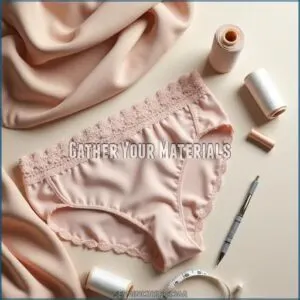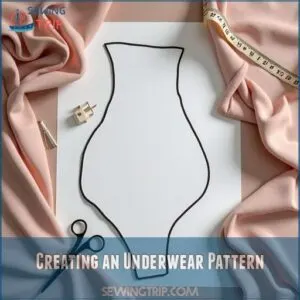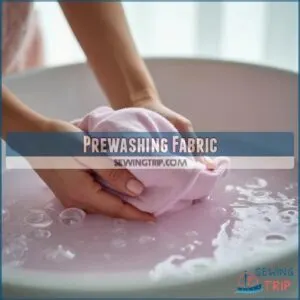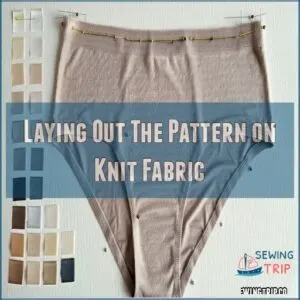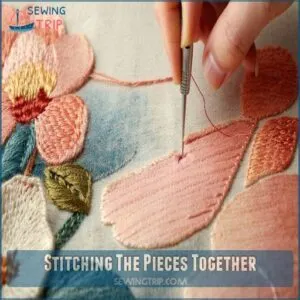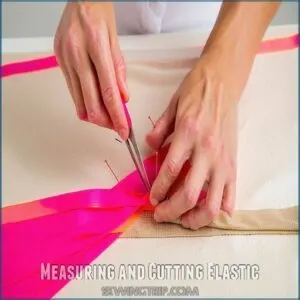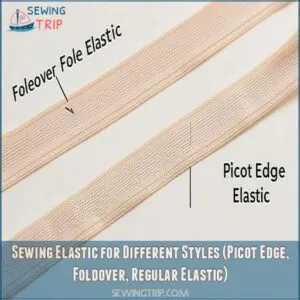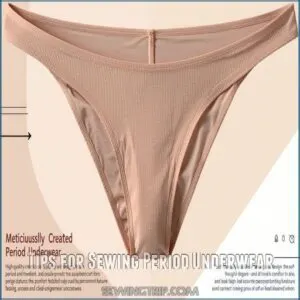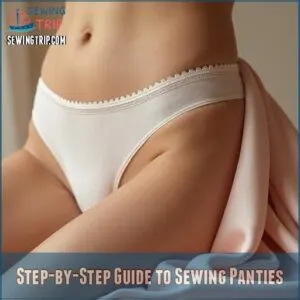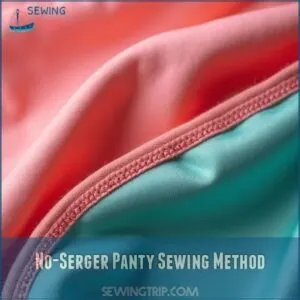This site is supported by our readers. We may earn a commission, at no cost to you, if you purchase through links.
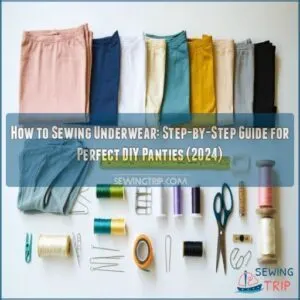 Ready to master sewing underwear?
Ready to master sewing underwear?
Start by choosing stretchy knit fabric like cotton jersey and grabbing the right elastic widths (½-1 inch for waistbands, ¼-½ inch for leg openings).
You’ll need a ballpoint needle sized 70/10 or 80/12 for your machine.
Trace your favorite pair for a pattern, adding a 1cm seam allowance.
Use a narrow zigzag stitch to join the pieces, starting with the back and crotch before attaching the front.
Finish by applying elastic with a zigzag stitch – just remember to add an extra inch or two for overlap.
There’s nothing quite like the satisfaction of wearing underwear you’ve crafted yourself.
Table Of Contents
- Key Takeaways
- Gather Your Materials
- Understanding The Basics of Underwear Construction
- Stitching The Pieces Together
- Sewing Elastic in Underwear
- Tips for Sewing Period Underwear
- Step-by-Step Guide to Sewing Panties
- Ideas for Embellishments and Customizations
- No-Serger Panty Sewing Method
- Free Panties Patterns and Customization Options
- Professional Finish With Singer Brother Janome Sewing Blind Hem Foot
- Frequently Asked Questions (FAQs)
- Conclusion
Key Takeaways
- You’ll need stretchy knit fabrics like cotton jersey, appropriate elastic widths (½-1" for waistbands, ¼-½" for leg openings), and a ballpoint needle (70/10 or 80/12) for your sewing machine.
- Create your pattern by tracing a favorite pair of underwear and adding a 1cm seam allowance, then use a narrow zigzag stitch (2mm length, 0.5mm width) to join pieces, starting with the back and crotch before attaching the front.
- You don’t need a serger—a regular sewing machine with a zigzag stitch works well for constructing underwear, though you’ll want to test your stitch settings on scraps first.
- When attaching elastic, add 1–2 inches for overlap, pin quarter marks for even distribution, and stretch gently while sewing to ensure a comfortable, professional finish.
Gather Your Materials
Before you start creating your perfect pair of DIY underwear, you’ll need to round up your materials.
like stretchy fabric, elastic trims, and a ballpoint needle for your sewing machine.
You’ll love how simple it’s to gather everything you need – just think of it as putting together the ingredients for a comfy, custom-made recipe that’ll fit you just right.
Recommended Fabrics
Choosing the perfect fabric for your DIY underwear is like picking the right partner – it needs to feel just right.
When selecting a knit fabric, remember to think about its recovery properties for best fabric recovery.
You’ll want stretchy, breathable knits that love your skin.
Cotton jersey and modal are your best friends here, offering comfort and moisture-wicking properties.
For special needs like period underwear, consider specialty fabrics like merino wool, zorb, or PUL for extra protection.
Elastic Options
The right elastic can make or break your DIY underwear project! Let’s break down your essential elastic options:
- Waistbands need 1/2" to 1" wide regular elastic for stability, and you can find a variety of 1/2 inch elastic options at this online store.
- Leg openings work best with 1/4" to 1/2" picot edge or stretchy lace
- Foldover elastic offers a clean, professional finish
- Plush-backed elastic means maximum comfort
- Always match elastic width to your pattern specs
Remember: quality elastic means better-fitting, longer-lasting undies!
Sewing Machine and Needle Requirements
Your sewing machine’s needle choice can make or break your underwear project.
Grab a ballpoint needle (size 70/10 or 80/12) – they’re designed to slip between knit fibers without snagging.
Set your machine to a narrow zigzag stitch (2mm length, 0.5mm width) to allow stretch.
Test your settings on scraps first, and remember to swap needles regularly since dull ones cause skipped stitches and snags.
Understanding The Basics of Underwear Construction
You’ll be amazed at how simple it’s to create your own perfectly fitting underwear once you understand the basic construction methods.
Before you start sewing, you’ll need to master three key steps: creating a custom pattern from your favorite pair, prewashing your chosen knit fabric to prevent future shrinkage, and properly laying out your pattern pieces along the fabric’s grainline.
Creating an Underwear Pattern
Now that you’ve gathered your materials, including smooth, stretchy fabrics like jersey or modal and soft elastic.
Let’s create a pattern that perfectly fits your body.
Start by laying your favorite underwear flat and folded in half lengthwise. Trace its outline onto pattern paper, adding 1 cm seam allowances around all edges. Be sure to account for the grainline and knit fabrics.
Test your pattern with scrap fabric and make tweaks until you’re happy with the fit. You’ll master pattern drafting in no time!
Prewashing Fabric
Before diving into your sewing project, proper fabric preparation makes all the difference in creating underwear that fits perfectly and lasts longer. You can find a variety of prewash underwear fabric options at prewash underwear fabric.
- Choose cold water for delicate fabrics like silk and modal
- Use warm water for cotton and cotton blends
- Line dry or use low heat in the dryer
- Test a small fabric swatch first
- Allow fabric to dry completely before cutting
Laying Out The Pattern on Knit Fabric
Identifying the grainline on knit fabric sets the foundation for flawless underwear construction.
Look for tiny vertical "ribs" running parallel to the selvage edge – these are your fabric’s natural grain lines.
Lay your pattern pieces with these ribs perfectly straight, avoiding any stretching or distortion. Pin strategically at the corners and along seam allowances, maintaining the fabric’s natural stretch properties throughout. flawless underwear construction. natural grain lines.
Stitching The Pieces Together
Now that you’ve got your pattern pieces ready, you’ll learn how to transform them into a comfortable pair of underwear that fits just right.
You’ll start by joining the back piece with the crotch pieces,
then attach the front piece using specific stitches that’ll keep everything secure and stretchy.
Assembling The Back Piece and Crotch Pieces
Let’s get your back piece and crotch pieces perfectly aligned – it’s like putting together a puzzle where every piece needs to fit just right!
Start by sandwiching your back piece between the two crotch pieces, matching up those seams.
Pin everything in place, and then use your serger or a zigzag stitch (about 2mm long, 0.5mm wide) to secure them together. Take it slow – there’s no race here!
Attaching The Front Piece
Now that you’ve assembled the back and crotch pieces, it’s time to attach the front piece. This step requires careful attention to alignment and seam accuracy, and to guarantee a professional finish, press seams for a professional look as you go along.
Pin the front piece to the assembled back and crotch pieces, right sides together considering fabric compatibility.
- Match notches and center points for perfect alignment
- Use plenty of pins to prevent fabric shifting
- Keep fabric edges even while sewing
- Maintain consistent seam allowance throughout
Finishing Raw Fabric Edges
Raw edges can make or break your handmade underwear’s durability.
After attaching your front piece, you’ll want to finish those edges with an overlock stitch for a polished look.
Here’s what works best:
| Serger Stitch Options | Description |
|---|---|
| 3-thread overlock | Basic overlocking stitch |
| 4-thread overlock | Wide overlock stitch |
| Rolled edge | Narrow overlock for lightweight fabrics |
Trim close to seams before overlocking for professional results.
Sewing Elastic in Underwear
You’ll love how elastic transforms your handmade underwear from flat fabric into perfectly fitted, professional-looking panties.
Whether you’re using picot edge, foldover, or regular elastic, you’ll learn the essential techniques to create underwear that’s both comfortable and stays securely in place.
Measuring and Cutting Elastic
Elastic serves as the unsung hero of perfectly fitted underwear – get it right, and you’ll never look back.
Here’s your quick guide to nailing the measurements:
- Add 1-2 inches overlap when measuring waist/leg openings
- Make clean cuts with sharp scissors for even edges
- Create quarter marks with pins for balanced stretch
- Pin elastic to fabric’s right side, matching marks
- Test fit and adjust pins as needed
Sewing Elastic for Different Styles (Picot Edge, Foldover, Regular Elastic)
After measuring your elastic pieces, you’ll face the fun challenge of choosing between three popular elastic styles that’ll give your handmade underwear that professional finish. For a seamless look, consider using foldover elastic underwear which creates the cleanest look with no visible stitching.
- Foldover elastic creates the cleanest look with no visible stitching
- Picot edge adds a delicate, feminine touch perfect for special occasion pieces
- Regular elastic offers the most stability and support
- Wide elastic bands create a retro-inspired waistband
- Decorative elastic can double as both functional and stylish trim
Tips for Sewing Period Underwear
You’ll find that sewing your own period underwear isn’t just budget-friendly – it’s also a smart way to create comfortable, leak-proof protection that fits your unique needs.
Whether you’re using specialty fabrics like zorb or PUL, or adding custom touches like hidden pockets for heating pads,
you’ll soon master the techniques to make period underwear that works better than store-bought options.
Choosing Specialty Fabrics
Taking control of your period protection starts with choosing the right specialty fabrics.
For maximum absorption, layer zorb fabric in the gusset area – it’s a game-changer for leak protection.
Consider PUL fabric as your waterproof barrier, while cotton jersey or modal handles moisture-wicking duties.
For temperature regulation, merino wool is your best friend.
Active? Look for high-performance athleisure materials that move with you.
Care Instructions for Period Underwear
Now that you’ve selected your specialty fabrics, let’s master the care routine for your DIY period underwear.
Proper maintenance will keep them working like a charm.
| Action | Details |
|---|---|
| Rinsing | Cool water rinse after use. Skip hot water. |
| Air Drying | Hang or lay flat. No dryer. |
| Stain Removal | Pre-treat with hydrogen peroxide, lemon juice, or oxyclean. |
| Washing | Cold water, delicate cycle, gentle detergent. |
Personalizing Your Period Underwear
With the basics of maintenance covered, let’s make your period underwear uniquely yours.
Start by adding feminine touches like delicate lace panels along the sides or decorative trim around the edges.
Express yourself with bold prints or fun fabric combinations – think mesh panels or metallic accents.
For practical comfort, consider adding a hidden pocket to hold a heating pad or essential items.
Step-by-Step Guide to Sewing Panties
You’ll be amazed at how simple it’s to create your own perfectly fitting panties.
with just a few basic sewing skills and materials.
Whether you’re a beginner or experienced seamstress, this guide will walk you through every step of the process, from cutting your fabric to adding those professional-looking elastic finishes.
Cutting The Fabric
Once you’ve got your period-proof layers sorted, let’s focus on getting those fabric pieces just right.
Start by laying out your fabric on a flat surface, making sure the grain lines run parallel to the selvage.
Place your pattern pieces following the grain direction and pin them securely. Cut carefully with sharp scissors, leaving those all-important seam allowances. Don’t forget to mark any notches – they’ll be your best friends later.
Sewing The Panties
Laying out your freshly cut fabric pieces, start by sandwiching the back piece between the two crotch pieces, aligning all seams carefully.
Use a narrow zigzag stitch (2mm long, 0.5mm wide) to join them together.
Next, attach the front piece to your assembled back and crotch sections.
Remember to test your stitch settings on scrap fabric first to guarantee smooth seams without any unwanted fabric bunching.
Sewing Different Elastic Styles
Elastic application makes or breaks your DIY underwear project.
Let’s master three essential styles:
To achieve a professional finish when sewing elastic, refer to the steps outlined in the guide on how to elastic sew.
| Elastic Style | Description | Tips |
|---|---|---|
| Wide Elastic | Use for waistband. Provides stretch and structure. | Stitch to inside waistband with zigzag stitch. Overlap ends. |
| Picot Edge | Gives a delicate, lacy effect. Use for leg openings. | Stitch to right side with twin needle for professional finish. |
| Foldover Elastic | Creates a thicker waistband when folded. No casing needed. | Fold elastic to encase raw edge. Stitch using zigzag stitch. |
Ideas for Embellishments and Customizations
You’ll love how a few simple touches can transform your handmade underwear from basic to boutique-worthy.
Whether you’re adding delicate bows, mixing fun fabric patterns, or trying out different elastic styles, these personalized details will make your DIY underwear uniquely yours.
Adding Bows, Crystals, and Buttons
Now that you’ve mastered the basics of sewing panties, let’s add some sparkle to your creations! A few well-placed embellishments can transform basic underwear into boutique-worthy pieces.
Here are three fool-proof ways to decorate:
- Sew tiny bows using ribbon or lace at the center front waistband
- Attach flat-back crystals with fabric glue, spacing them evenly
- Add decorative buttons using strong thread and a secure backstitch
Mixing Fabric Colors or Patterns
While basic solid-colored underwear serves its purpose, mixing fabrics and patterns lets you create truly unique pieces.
Try pairing floral prints with stripes, or combine polka dots with geometric patterns for eye-catching results.
You can even mix textures by combining smooth jersey with lace panels.
Just remember to keep similar fabric weights together to maintain comfort and durability.
Using Picot Edge Elastic on Nighties and Camisoles
Transform your nighties and camisoles into luxurious lingerie with picot edge elastic – that delicate, scalloped trim that adds a professional touch.
For a similar look, consider using fold-over elastic for underwear, which finishes raw edges and provides a comfortable fit.
You’ll love how this dainty edging elevates simple pieces into something special.
Simply attach it along hems and necklines using a zigzag stitch, stretching gently as you sew.
For best results, use 1/4" to 3/8" width for a flattering, feminine finish.
No-Serger Panty Sewing Method
You don’t need fancy equipment to create comfortable, custom-fit underwear at home.
Just your regular sewing machine and some basic supplies will do the trick.
With a simple zigzag stitch and proper technique, you’ll be able to transform old t-shirts or stretchy fabric into perfectly wearable panties that rival store-bought ones. This is a great way to make comfortable, custom-fit underwear.
Using Minimal Fabric (e.g., Old T-shirts)
Resourceful sewists can create comfortable underwear from fabric scraps and old t-shirts, making sustainable DIY panties a budget-friendly option.
You’ll need just a handful of materials:
- Soft, stretchy t-shirt fabric (old shirts work great)
- Mesh or lace trim (optional)
- Silky camisole remnants
- Thrifted knit garments
This eco-friendly approach lets you express creativity while giving new life to old clothes.
Sewing Process Using a Regular Sewing Machine
After gathering your materials, let’s put your regular sewing machine to work.
Set your machine to a narrow zigzag stitch (2mm length, 0.5mm width) and lower the tension for stretchy fabrics.
Pin your pieces together, then start at the crotch seam. Sandwich the layers carefully, and stitch slowly around curves.
Remember to backstitch at the beginning and end of each seam for durability.
Maintaining Fabric Stretchiness With a Zigzag Stitch
Now that you’ve got your sewing machine ready, let’s keep your fabric’s natural stretch intact with the right zigzag stitch settings. Think of zigzag stitches as tiny springs that move with your fabric – they’re your secret weapon for comfy underwear.
- Set stitch width to 3-4mm for best flexibility
- Adjust stitch length to 1-2mm for secure seams
- Keep thread tension balanced to prevent puckering
- Test settings on fabric scraps first
- Stretch fabric edges gently while sewing
Remember to sew with light pressure and steady speed. Pull the fabric slightly as you guide it through your machine, ensuring the seams can stretch naturally with movement.
Free Panties Patterns and Customization Options
You’ll be amazed at how easy it’s to create your own custom-fit underwear.
using free patterns that you can find online or by tracing your favorite pair.
Whether you’re looking to make basic everyday panties or fancy lace-trimmed pieces, you’ll find plenty of options to match your style and skill level.
Tracing Existing Panties for a Custom Pattern
Creating your own underwear pattern is surprisingly simple when you start with a well-fitting pair.
Begin by laying your favorite panties flat on pattern paper, carefully pinning them down at key points.
Trace the outline, making sure to mark essential elements like the waistline and crotch area. Add 1 cm seam allowances around all edges, and you’ll have a custom pattern that perfectly matches your shape. perfectly matches your shape.
Elastic Placement Tips
Elastic placement makes or breaks your handmade underwear’s comfort.
Once you’ve traced your pattern, mark these key points: center back, center front, and halfway along the legs.
These strategic spots guarantee your elastic hugs without squeezing.
| Elastic Type | Placement Tips |
|---|---|
| Waistband | Center Back + Center Front |
| Leg Openings | Halfway Along Legs |
| Picot Edge | Decorative Accents |
| Foldover | Enclose Edges |
Exploring Various Free Panties Patterns Online
Free panties patterns give you the power to create exactly what you want, with thousands of options just a click away.
Start with basic styles like bikini or boyshorts, then experiment with high-waisted, hipster, or thong variations.
Most patterns include helpful sizing charts and fabric recommendations.
Look for patterns labeled "beginner-friendly" with step-by-step photos and user reviews to boost your confidence.
Professional Finish With Singer Brother Janome Sewing Blind Hem Foot
Taking your DIY underwear from homemade to boutique-worthy is easier than you think with a blind hem foot. This handy attachment, compatible with Singer, Brother, and Janome machines, helps you create nearly invisible seams that look professionally finished.
Here’s how to nail that polished look:
- Press the hem allowance inward, keeping the right side visible
- Align your fabric’s folded edge with the foot’s metal guide
- Use a slow, steady pace while sewing, letting the zigzag catch just a few fabric threads
Pro tip: Practice on scrap fabric first – it’s like learning to parallel park, you’ll get better with each attempt. Once you’ve mastered the technique, your underwear will have that high-end finish that makes you proud to say "I made these myself!
Frequently Asked Questions (FAQs)
How hard is it to sew your own underwear?
Sewing your own underwear isn’t too challenging if you’ve got basic machine skills.
You’ll need stretchy fabric, elastic, and about an hour.
It’s like making a simple puzzle – just follow the pattern’s pieces.
Is it worth it to make your own underwear?
Imagine slipping on perfectly fitting underwear you’ve crafted yourself – it’s definitely worth it!
You’ll save money in the long run.
You’ll customize your fit exactly.
And you’ll express creativity while learning valuable sewing skills.
What stitch is used for underwear?
You’ll want to use a narrow zigzag stitch (2mm long, 5mm wide) for stretchy fabrics.
For finishing edges, an overlock stitch works best.
Always test your stitches on scrap fabric first.
Do you need a serger to sew underwear?
Ready to start making your own underwear?
You don’t need a serger – a regular sewing machine works great with stretch or zigzag stitches.
Just use a ballpoint needle and adjust your stitch settings for knit fabrics.
How to prevent fabric from bunching while sewing?
Hold your fabric firmly but gently while feeding it through.
Use a walking foot attachment.
Set stitch length to 5mm, and reduce presser foot pressure.
Test settings on scrap fabric first for best results.
What interfacing works best for delicate underwear fabrics?
Light as a feather, fusible tricot interfacing is your best friend for delicate fabrics.
It adds stability without bulk and won’t damage silk or lace.
Choose ultra-lightweight options for maximum drape retention.
Can I use regular thread for stretchy fabrics?
You’ll want to use polyester thread specifically designed for stretch fabrics.
Regular thread can snap when stretched, while specialty thread maintains elasticity and strength.
Consider using wooly nylon thread for seams.
How to fix uneven gusset seams after sewing?
Unpick the uneven gusset seams with a seam ripper.
Then repin the layers together carefully.
Use plenty of pins and sew slowly with a walking foot to maintain even fabric feed while stitching.
Should underwear patterns account for fabric stretch percentage?
Your pattern needs to account for stretch percentage.
It’s essential for a proper fit.
Reduce pattern width by 10-25% for highly stretchy fabrics like spandex.
while keeping the full size for less stretchy materials.
Conclusion
Now that you’ve mastered how to sewing underwear, you’re ready to create your own collection of comfortable, stylish panties.
Whether you’re making everyday basics or fancy lingerie, you’ll save money while expressing your creativity.
Remember to practice with less expensive fabrics first, and don’t get discouraged if your first attempts aren’t perfect.
With each pair you make, your skills will improve. Soon you’ll be confidently sewing underwear that fits better than anything from the store.

